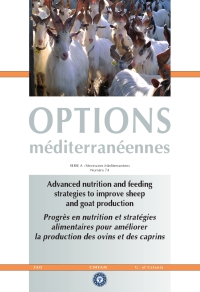| Article précédent | p. 457-461 |
Prediction of some Tunisian roughages voluntary intake by Noire de Thibar ewes
The present study aims at predicting the voluntary intake of different roughages by ewes. Rations based on Egyptian clover (Trifolium alexandrium), oat (Avena sativa), barley (Hordeum vulgare) Souihli, barley Manel, vetch (Vicia sativa)-oat silage, and vetch-oat hay were distributed ad libitum twice a day during different periods of 4 weeks each to 6 black-thibar ewes (age = 4 years and body weight = 57 kg). Ewes' regimen was enriched by 10 g/Kg LW0.75 of concentrate and by 30 g/animal daily of a commercial mixture of minerals and vitamins. Chemical composition (DM, CP, NDF, and CF) was determined for each roughage. Ruminal degradability of these roughages was determined using the technique of nylon bags and was modelled as: Dg = a + b (1-e-ct), where Dg is the ruminal degradability in time t and a, b and c are constants. The CP and NDF contents ranged from 7.6 to 19.1% DM and from 42.0 to 58.3% DM, respectively. For the Dg parameters, the fraction a ranged from 5.2 to 23.5; the fraction b ranged from 51.1 to 71.2 and c ranged from 0.0114 to 0.0570. There were significant differences (p<0.05) among roughages with regard to immediately soluble fraction a, insoluble but degradable fraction b, and fraction rate of degradation c. The voluntary intake of roughages ranged from 784 g DM to 1104 g DM daily. Average silage intakes were 918 g DM daily. This low value may be related to the quality of roughage conservation. Roughage intake can be predicted based on chemical characteristics. The NDF and the CB contents with ruminal degradability parameters explained 34% of the total variation of roughage intake by Black-Thibar ewes (DMI g/Kg LW0.75 = -1470.46 + 5.93 CF + 10.39 NDF + 12.73 NDS + 2.15 a + 2.82 b.
L'objectif de cette étude est la prédiction de l'ingestion volontaire de différents fourrages par les brebis Noire de Thibar. Des rations basées sur le trèfle d'Alexandrie (Trifolium alexandrium), l'avoine (Avena sativa), l'orge (Hordeum vulgare) Souihli, l'orge Manel, l'ensilage de vesce (Vicia sativa)-avoine et foin de vesce-avoine, ont été distribuées à volonté 2 fois par jour pendant des périodes de 4 semaines chacune à 6 brebis (âge moyen = 4 ans et poids vif moyen = 57 kg). Les rations ont été complétées chaque jour par 10 g/Kg P0.75 de concentré et par 30 g/brebis de CMV. La composition chimique (MS, MAT, FND et FB) a été déterminée pour chaque ration. La dégradabilité des différents fourrages dans le rumen a été déterminée par la méthode des sachets de nylon et a été représentée par : Dg = a + b (1-e-ct), Dg étant la dégradabilité ruminale à un temps t et a, b et c étant des constantes. Les teneurs en MAT et FND ont varié respectivement de 7,6 à 19,1% et de 42,0 à 58,3% de MS. Les paramètres de dégradabilité ont aussi varié de 5,2 à 23,5, de 51,1 à 71,2 et de 0,0114 à 0,0570 respectivement pour a, b et c. Ces paramètres dépendaient (p<0,05) de la nature du fourrage. L'ingestion volontaire des fourrages oscillait de 784 à 1104 g MS par jour et était faible pour l'ensilage de vesce-avoine (918 g MS par jour). Cette faible ingestion est imputée à sa qualité de conservation. La prédiction de l'ingestion des fourrages à partir de leur composition chimique et leurs paramètres de dégradabilité est possible. Ainsi l'équation de prédiction est MSI g/Kg P0.75 = -1470,46 + 5,93 FB + 10,39 FND + 12,73 NDS + 2,15 a + 2,82 b avec un coefficient de détermination de 34%.
- [ Afficher ]
- [ Télécharger ]
- [ Exporter la citation ]
Vous pouvez télécharger la citation au format :
- [ Imprimer ]
-
Mots-clés
AVENA SATIVA, BREBIS, COMPOSITION CHIMIQUE, DIGESTION DU RUMEN, ENSILAGE (PRODUIT), EXPERIMENTATION, FOURRAGE VERT, HORDEUM VULGARE, PRISE ALIMENTAIRE (ANIMAUX), TRIFOLIUM ALEXANDRIUMCiter cet article
Rouissi H., Chermiti A., Hammami M., Toukebri H., Rekik B. Prediction of some Tunisian roughages voluntary intake by Noire de Thibar ewes. In : Priolo A. (ed.), Biondi L. (ed.), Ben Salem H. (ed.), Morand-Fehr P. (ed.). Advanced nutrition and feeding strategies to improve sheep and goat . Zaragoza : CIHEAM, 2007. p. 457-461. (Options Méditerranéennes : Série A. Séminaires Méditerranéens; n. 74). 11. Seminar of the FAO-CIHEAM Sub-Network on Sheep and Goat Nutrition, 2005/09/08-10, Catania (Italy). http://om.ciheam.org/om/pdf/a74/00800413.pdf



